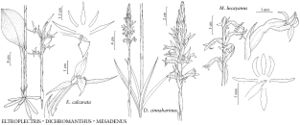Dichromanthus cinnabarinus
Bot. Mus. Leafl. 28: 314. 1982.
Plants 50–90 cm. Roots 7–12, tuberous, fasciculate, large, 12 × 1 cm, fleshy. Stems with 6–9 bladeless cauline sheaths, green. Leaves present at anthesis, 3–4, ascending stem, dark green, linear-oblanceolate, 10–20 × 1.5–3 cm, passing into orange bracts with green stripes. Inflorescences congested, 30–40-flowered spikes, 4–17 cm, minutely papillose; floral bracts red, lanceolate, 3.5–8 mm. Flowers yellow-orange to scarlet, tubular; perianth apices strongly recurved; ovaries red, stout, 10 × 4 mm, pubescent; sepals sparingly pubescent; dorsal sepal recurved, vermilion, lanceolate, 15–20 × 3–4 mm; lateral sepals linear-lanceolate, 15–22 × 2–3.5 mm, apex acute; petals yellow with vermilion apex, linear, falcate, 15–20 × 2–2.5 mm; lip yellow with vermilion apex, lanceolate, concave proximal to middle, 15–20 × 3–5 mm; column 9 mm, thick, papillose; rostellum flat, slender, 2–3 mm; anther abaxial.
Phenology: Flowering Jul–Oct.
Habitat: Rocky mountain slopes, grassy hills and canyon meadows, often in limestone
Elevation: 1800 m
Distribution

Tex., Mexico, Central America (Guatemala).
Discussion
Selected References
None.
